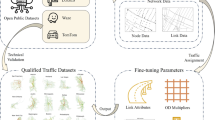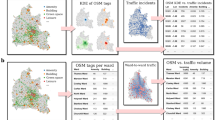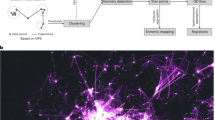Abstract
Previous studies have reported that lower-income and minority populations are more likely to live near major roads. This study quantifies associations between socioeconomic status, racial/ethnic variables, and traffic-related exposure metrics for the United States. Using geographic information systems (GIS), traffic-related exposure metrics were represented by road and traffic densities at the census tract level. Spearman's correlation coefficients estimated relationships between socio-demographic variables and traffic-related exposure metrics, and ANOVA was performed to test for significant differences in socio-demographic variables for census tracts with low and high traffic-related metrics. For all census tracts in the United States, %Whites, %Blacks, and %Hispanics (percent of tract population) had correlation coefficients greater than 0.38 and 0.16 with road density and traffic density, respectively. Regions and states had correlation coefficients as high as 0.78. Compared with tracts with low road and traffic densities (<25th percentile), tracts with high densities (>75th percentile) had values of %Blacks and %Hispanics that were more than twice as high, 20% greater poverty levels, and one-third fewer White residents. Census tracts that had mid-level values for road and traffic densities had the most affluent characteristics. Results suggest that racial/ethnic and socioeconomic disparities exist on national level with respect to lower-income and minority populations living near high traffic and road density areas.
This is a preview of subscription content, access via your institution
Access options
Subscribe to this journal
Receive 6 print issues and online access
$259.00 per year
only $43.17 per issue
Buy this article
- Purchase on Springer Link
- Instant access to full article PDF
Prices may be subject to local taxes which are calculated during checkout


Similar content being viewed by others
References
USEPA National emissions inventory (NEI) air pollutant emissions trends data. 2008 Accessed July 2011, http://www.epa.gov/ttn/chief/trends/.
Gehring U, Heinrich J, Krämer U, Grote V, Hochadel M, Sugiri D et al. Long-term exposure to ambient air pollution and cardiopulmonary mortality in women. Epidemiology 2006; 17 (5): 545.
Reynolds P, Von Behren J, Gunier RB, Goldberg DE, Hertz A . Residential exposure to traffic in California and childhood cancer. Epidemiology 2004; 15 (1): 6.
Finkelstein MM, Jerrett M, Sears MR . Environmental inequality and circulatory disease mortality gradients. J Epidemiol Commun H 2005; 59 (6): 481.
Hoek G, Brunekreef B, Goldbohm S, Fischer P, van den Brandt PA . Association between mortality and indicators of traffic-related air pollution in the Netherlands: a cohort study. The Lancet 2002; 360 (9341): 1203–1209.
Slama R, Morgenstern V, Cyrys J, Zutavern A, Herbarth O, Wichmann HE et al. Traffic-related atmospheric pollutants levels during pregnancy and offspring's term birth weight: a study relying on a land-use regression exposure model. Environ Health Persp 2007; 115 (9): 1283.
Burr M, Karani G, Davies B, Holmes B, Williams K . Effects on respiratory health of a reduction in air pollution from vehicle exhaust emissions. Occup Environ Med 2004; 61 (3): 212.
Brauer M, Hoek G, Smit H, De Jongste J, Gerritsen J, Postma DS et al. Air pollution and development of asthma, allergy and infections in a birth cohort. Eur Respir J 2007; 29 (5): 879.
Morgenstern V, Zutavern A, Cyrys J, Brockow I, Koletzko S, Kramer U et al. Atopic diseases, allergic sensitization, and exposure to traffic-related air pollution in children. Am J Respir Crit Care Med 2008; 177 (12): 1331.
Beelen R, Hoek G, Van Den Brandt PA, Goldbohm RA, Fischer P, Schouten LJ et al. Long-term effects of traffic-related air pollution on mortality in a Dutch cohort (NLCS-AIR study). Environ Health Persp 2008; 116 (2): 196.
Gauderman WJ, Vora H, McConnell R, Berhane K, Gilliland F, Thomas D et al. Effect of exposure to traffic on lung development from 10 to 18 years of age: a cohort study. The Lancet 2007; 369 (9561): 571–577.
Zhu Y, Hinds WC, Kim S, Sioutas C . Concentration and size distribution of ultrafine particles near a major highway. J Air Waste Manag Assoc 2002; 52 (9): 1032–1042.
Beckerman B, Jerrett M, Brook JR, Verma DK, Arain MA, Finkelstein MM . Correlation of nitrogen dioxide with other traffic pollutants near a major expressway. Atmos Environ 2008; 42 (2): 275–290.
Health Effects Institute Panel on the Health Effects of Traffic-Related Air Pollution. Traffic-Related Air Pollution: A Critical Review of the Literature on Emissions Exposure, Health Effects. Health Effects Institue: Boston, MA, 1974.
Brunekreef B, Janssen NAH, de Hartog J, Harssema H, Knape M, van Vliet P . Air pollution from truck traffic and lung function in children living near motorways. Epidemiology 1997; 8 (3): 298–303.
McConnell R, Berhane K, Yao L, Jerrett M, Lurmann F, Gilliland F et al. Traffic, susceptibility, and childhood asthma. Environ Health Persp 2006; 114 (5): 766.
Baumann LM, Robinson CL, Combe JM, Gomez A, Romero K, Gilman RH et al. Effects of distance from a heavily transited avenue on asthma and atopy in a periurban shantytown in Lima, Peru. J Allergy Clin Immunol 2011; 127 (4): 875–882.
Venn AJ, Lewis SA, Cooper M, Hubbard R, Britton J . Living near a main road and the risk of wheezing illness in children. Am J Respir Crit Care Med 2001; 164 (12): 2177.
Hoffmann B, Moebus S, Stang A, Beck EM, Dragano N, Möhlenkamp S et al. Residence close to high traffic and prevalence of coronary heart disease. Eur Heart J 2006; 27 (22): 2696.
Hoffmann B, Moebus S, Möhlenkamp S, Stang A, Lehmann N, Dragano N et al. Residential exposure to traffic is associated with coronary atherosclerosis. Circulation 2007; 116 (5): 489–496.
Finkelstein MM, Jerrett M, DeLuca P, Finkelstein N, Verma DK, Chapman K et al. Relation between income, air pollution and mortality: a cohort study. Can Med Assoc J 2003; 169 (5): 397.
Jerrett M, Burnett R, Brook J, Kanaroglou P, Giovis C, Finkelstein N et al. Do socioeconomic characteristics modify the short term association between air pollution and mortality? Evidence from a zonal time series in Hamilton, Canada. J Epidemiol Commun H 2004; 58 (1): 31.
Apelberg BJ, Buckley TJ, White RH . Socioeconomic and racial disparities in cancer risk from air toxics in Maryland. Environ Health Persp 2005; 113 (6): 693.
Wu YC, Batterman SA . Proximity of schools in Detroit, Michigan to automobile and truck traffic. J Expo Sci Environ Epidemiol 2006; 16 (5): 457–470.
Morello-Frosch R, Pastor M, Sadd J . Environmental justice and Southern California's “Riskscape”. Urban Aff Rev 2001; 36 (4): 551.
Pastor JM, Morello Frosch R, Sadd JL . The air is always cleaner on the other side: race, space, and ambient air toxics exposures in California. J Urban Aff 2005; 27 (2): 127–148.
Gunier RB, Hertz A, Von Behren J, Reynolds P . Traffic density in California: socioeconomic and ethnic differences among potentially exposed children. J Expo Sci Environ Epidemiol 2003; 13 (3): 240–246.
Houston D, Wu J, Ong P, Winer A . Structural disparities of urban traffic in Southern California: implications for vehicle-related air pollution exposure in minority and high-poverty neighborhoods. J Urban Aff 2004; 26 (5): 565–592.
Tian N, Goovaerts P, Zhan FB, Wilson JG . Identification of racial disparities in breast cancer mortality: does scale matter? Int J Health Geogr 2010; 9 (1): 35.
Reynolds P, Von Behren J, Gunier RB, Goldberg DE, Hertz A, Smith D . Traffic patterns and childhood cancer incidence rates in California, United States. Cancer Causes Control 2002; 13: 665–673.
Bayer P, Keohane N, Timmins C . Migration and hedonic valuation: the case of air quality. J Environ Econ Manag 2009; 58 (1): 1–14.
Carey J, Semmens J . Impact of highways on property values: case study of superstition freeway corridor. J Transp Res Board 2003; 1839: 128–135.
Bae C, Sandlin G, Bassok A, Kim S . The exposure of disadvantaged populations in freeway air-pollution sheds: a case study of the Seattle and Portland regions. Environ Plan B Plan Des 2007; 34 (1): 154–170.
Ross Z, Jerrett M, Ito K, Tempalski B, Thurston GD . A land use regression for predicting fine particulate matter concentrations in the New York City region. Atmos Environ 2007; 41 (11): 2255–2269.
Eckel SP, Berhane K, Salam MT, Rappaport EB, Linn WS, Bastain TM et al. Residential traffic-related pollution exposures and exhaled nitric oxide in the children's health study. Environ Health Perspect 2011.
Jerrett M, Burnett RT, Kanaroglou P, Eyles J, Finkelstein N, Giovis C et al. A GIS-environmental justice analysis of particulate air pollution in Hamilton, Canada. Environ Plan A 2001; 33 (6): 955–974.
Chang J, Delfino R, Gillen D, Tjoa T, Nickerson B, Cooper D . Repeated respiratory hospital encounters among children with asthma and residential proximity to traffic. Occup Environ Med 2009; 66 (2): 90.
Delfino RJ, Chang J, Wu J, Ren C, Tjoa T, Nickerson B et al. Repeated hospital encounters for asthma in children and exposure to traffic-related air pollution near the home. Ann Allergy Asthma Immunol 2009; 102 (2): 138–144.
Adar SD, Gold DR, Coull BA, Schwartz J, Stone PH, Suh H . Focused exposures to airborne traffic particles and heart rate variability in the elderly. Epidemiology 2007; 18 (1): 95.
Schwartz J, Litonjua A, Suh H, Verrier M, Zanobetti A, Syring M et al. Traffic related pollution and heart rate variability in a panel of elderly subjects. Thorax 2005; 60 (6): 455.
USEPA Fact sheet National Ambient Air Quality Standards for Caborn Monoxide-final rule. http://www.epa.gov/airquality/carbonmonoxide/pdfs/COFactSheetAugust12v4.pdf. 2011 Accessed 14 December 2011.
California Department of Education Senate Bill 352 New Determinations and Findings Required for California Department of Education Site Approval Related to Air Emissions. http://www.cashnet.org/resource-center/resourcefiles/344.pdf. 2004 Accessed on August 2011.
Acknowledgements
We are greatly thankful for all the technical reviewers of the manuscript, especially Andrew Geller and Karen Wesson of the Environmental Protection Agency.
Author information
Authors and Affiliations
Corresponding author
Ethics declarations
Competing interests
The authors declare no conflict of interest.
Additional information
Disclaimer
This article has been subject to review and approved for publication by the Office of Research and Development, the United States Environmental Protection Agency. Mention of trade names or commercial products does not constitute endorsement or recommendation for use.
Rights and permissions
About this article
Cite this article
Tian, N., Xue, J. & Barzyk, T. Evaluating socioeconomic and racial differences in traffic-related metrics in the United States using a GIS approach. J Expo Sci Environ Epidemiol 23, 215–222 (2013). https://doi.org/10.1038/jes.2012.83
Received:
Accepted:
Published:
Issue Date:
DOI: https://doi.org/10.1038/jes.2012.83
Keywords
This article is cited by
-
An environmental justice analysis of air pollution emissions in the United States from 1970 to 2010
Nature Communications (2024)
-
Prenatal exposure to ambient air pollution and traffic and indicators of adiposity in early childhood: the Healthy Start study
International Journal of Obesity (2022)
-
Asthma exacerbations and traffic: examining relationships using link-based traffic metrics and a comprehensive patient database
Environmental Health (2016)
-
Comparison of birth certificates and hospital-based birth data on pregnancy complications in Los Angeles and Orange County, California
BMC Pregnancy and Childbirth (2016)



